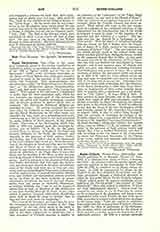

Royal Declaration, the.—This is the name most commonly given to the solemn repudiation of Catholicity which, in accordance with the provisions of the “Bill of Rights” (1689) and of “the Act of Succession” (1700), every sovereign succeeding to the throne of Great Britain was, until quite recently, required to make in the presence of the assembled Lords and Commons. This pronouncement has also often been called “the King’s Protestant Declaration” or “the Declaration against Transubstantiation” and (but quite incorrectly) “the Coronation Oath”. With regard to this last term it is important to notice that the later coronation oath, which for two centuries has formed part of the coronation service and which still remains unchanged, consists only of certain promises to govern justly and to maintain “the Protestant Reformed Religion established by Law“. No serious exception has ever been taken by Catholics to this particular formula, but the Royal Declaration, on the other hand, was regarded for long years as a substantial grievance, constituting as it did an insult to the faith professed by many millions of loyal subjects of the British Crown. The terms of this Declaration, which from 1689 to 1910 was imposed upon the sovereign by statute, ran as follows: “I, A. B., by the grace of God King (or Queen) of England, Scotland and Ireland, Defender of the Faith, do solemnly and sincerely in the presence of God, profess, testify, and declare, that I do believe that in the Sacrament of the Lord’s Supper there is not any Transubstantiation of the elements of bread and wine into the Body and Blood of Christ at or after the consecration thereof by any person whatsoever: and that the invocation or adoration of the Virgin Mary or any other Saint, and the Sacrifice of the Mass, as they are now used in the Church of Rome, are superstitious and idolatrous. And I do solemnly in the presence of God profess, testify, and declare that I do make this declaration, and every part thereof, in the plain and ordinary sense of the words read unto me, as they are commonly understood by English Protestants, without any evasion, equivocation, or mental reservation whatsoever, and without any dispensation already granted me by the Pope, or any other authority or person whatsoever, or without any hope of any such dispensation from any person or authority whatsoever, or without thinking that I am or can be acquitted before God or man, or absolved of this declaration or any part thereof, although the Pope, or any other person or persons, or power whatsoever, should dispense with or annul the same or declare that it was null and void from the beginning.”
The terms of the document are important, for even the extravagant and involved wording of the long rigmarole” at the end added much to the sense of studied insult conveyed by the whole formula. Not only is the Mass stigmatized as idolatrous, but a false statement of Catholic doctrine is implied in the reference to the “adoration” of the Virgin Mary and the saints “as now used in the Church of Rome“, while the existence of a supposed dispensing power is assumed which the Catholic Church has never asserted. What added still more to the just resentment of Catholics at the continued retention of the Declaration was the consciousness that, in the words of Lingard, it owed its origin “to the perjuries of an impostor and the delusion of a nation”. The formula was not one drafted by a Parliament in its sober senses. With the object of excluding Catholics from the throne, the Bill of Rights, after the deposition of James II in 1689, exacted of the monarch a profession of faith or “Test”. The test selected was one which already stood in the statute book, and which was first placed there during the frenzy excited by the supposed Popish Plot of 1678. It was amid the panic created by the fabrications of Titus Oates, that this Test was drafted (not improbably by Oates himself), and it was imposed upon all officials and public servants, thus effectually excluding Catholics from Parliament and positions of trust. By a curious inversion of history the declaration which was drawn up in 1678 to be taken by every official except the king, had come two hundred years later to be exacted only of the king and of no one else. Although statements have been made contending that the substance of the Royal Declaration is older than Titus Oates’ time, an examination of these earlier formulae shows little to support such a conclusion (see a full discussion in “The Tablet”, August 13, 1910, p. 243). A brief account of these formulae, and of the attempts which were made in 1891 and subsequent years to abolish or modify the Royal Declaration, has already been given in the article Oaths. It will be sufficient to cite here the terms of the new Declaration which was formally carried by Mr. Asquith’s Government in August, 1910, in time to relieve King George V from the necessity of wounding the feelings of his Catholic subjects by a repetition of the old formula. In virtue of Mr. Asquith’s “Accession Declaration Act” the brief statement, which now replaces that quoted above, runs as follows: “I, N, do solemnly and sincerely in the presence of God, profess, testify and declare that I am a faithful Protestant, and that I will, according to the true intent of the enactments to secure the Protestant Succession to the Throne of my realm, uphold and maintain such enactments to the best of my power.”
HERBERT THURSTON

